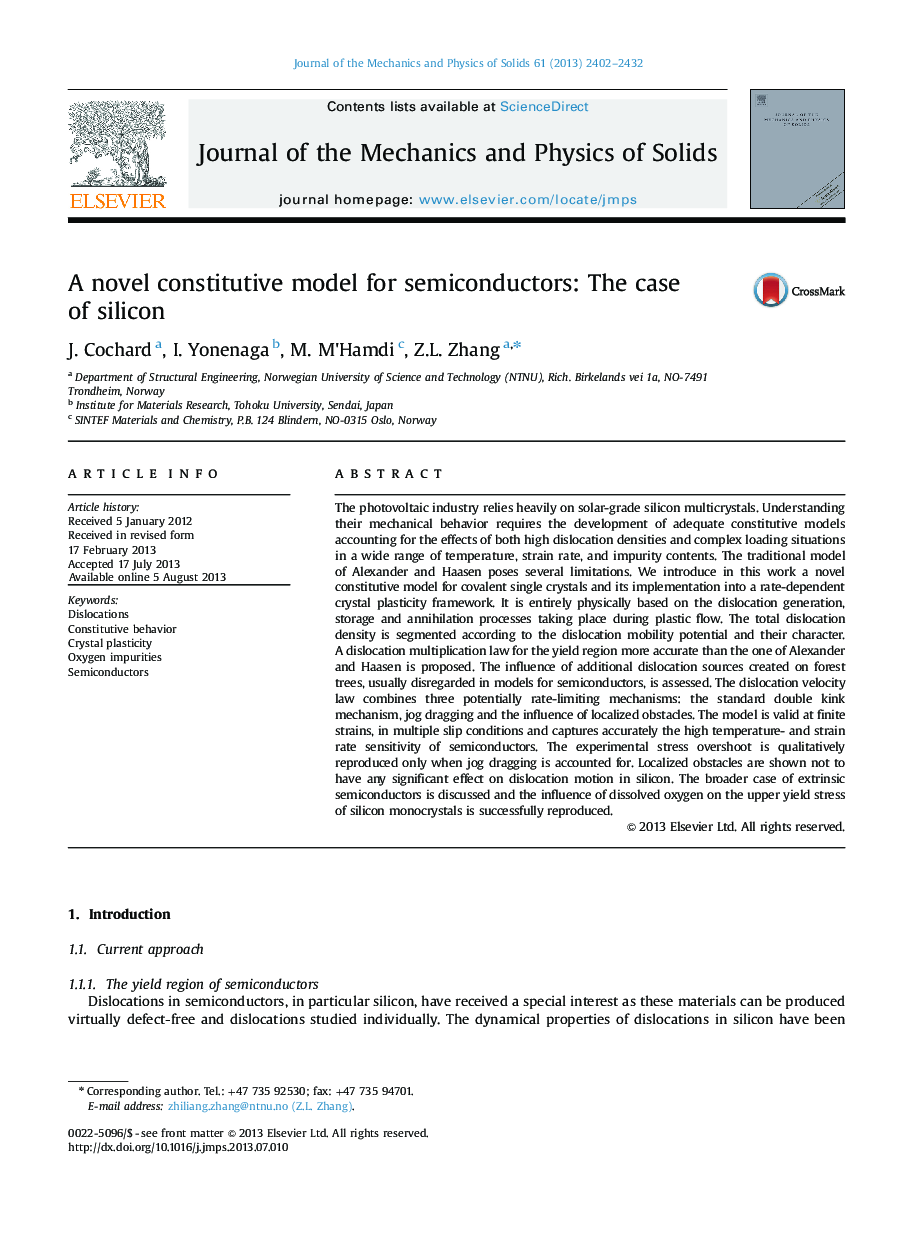| کد مقاله | کد نشریه | سال انتشار | مقاله انگلیسی | نسخه تمام متن |
|---|---|---|---|---|
| 7178331 | 1467082 | 2013 | 31 صفحه PDF | دانلود رایگان |
عنوان انگلیسی مقاله ISI
A novel constitutive model for semiconductors: The case of silicon
ترجمه فارسی عنوان
یک مدل سازنده جدید برای نیمه هادی ها: مورد سیلیکون
دانلود مقاله + سفارش ترجمه
دانلود مقاله ISI انگلیسی
رایگان برای ایرانیان
کلمات کلیدی
جابجایی، رفتار سازمانی، پلاستیک کریستال، ناخالصی های اکسیژن، نیمه هادی ها،
ترجمه چکیده
صنعت فتوولتائیک به شدت بر روی مولکولهای بلوری سیلیکون خورشیدی تکیه می کند. درک رفتار مکانیکی آنها نیاز به توسعه مدلهای سازنده کافی برای تأثیرات هر دو تراکم پراکندگی بالا و شرایط بارگیری پیچیده در طیف گسترده ای از درجه حرارت، میزان فشار و محتوای ناخالصی دارد. مدل سنتی الکساندر و هاآزن چندین محدودیت را ایجاد می کند. ما در این کار یک مدل سازنده جدید برای کریستال های تک کوانتال و اجرای آن به چارچوب پلاستیکی کریستال وابسته به سرعت معرفی می کنیم. این فیزیکی کاملا مبتنی بر فرایندهای تولید، ذخیره سازی و نابودی جابجایی در جریان جریان پلاستیک است. تراکم جابجایی کل بر اساس پتانسیل تحرک جابجایی و شخصیت آنها تقسیم می شود. قانون اصلاح جابجایی برای منطقه عملکرد دقیق تر از الکساندر و هاآسن پیشنهاد شده است. تأثیر منابع اضلاع ویرانگر ایجاد شده در درختان جنگل، معمولا در مدلهای نیمه هادی ها نادیده گرفته می شود. قانون سرعت جابجایی ترکیبی از سه مکانیزم محدود کننده سرعت است: مکانیسم دوقطبی استاندارد دوقطبی، کشیدن قوسی و تاثیر موانع موضعی. این مدل در سویه های محدود، در شرایط لغزش چندگانه معتبر است و حساسیت بالا نسبت به دمای بالا و فشار نیمه هادی ها را دقیق می کند. بیش از حد استرس آزمایشی، فقط هنگامی که کشیدن جادو به حساب می آید، کافی است. موانع موضعی نشان می دهد که هیچ اثر معنی داری بر حرکت جابجایی در سیلیکون ندارد. مورد وسیعتری از نیمه هادی های بیرونی مورد بحث قرار گرفته است و تأثیر اکسیژن محلول در تنش بالا بر روی تک کریستال های سیلیکون با موفقیت تولید می شود.
موضوعات مرتبط
مهندسی و علوم پایه
سایر رشته های مهندسی
مهندسی مکانیک
چکیده انگلیسی
The photovoltaic industry relies heavily on solar-grade silicon multicrystals. Understanding their mechanical behavior requires the development of adequate constitutive models accounting for the effects of both high dislocation densities and complex loading situations in a wide range of temperature, strain rate, and impurity contents. The traditional model of Alexander and Haasen poses several limitations. We introduce in this work a novel constitutive model for covalent single crystals and its implementation into a rate-dependent crystal plasticity framework. It is entirely physically based on the dislocation generation, storage and annihilation processes taking place during plastic flow. The total dislocation density is segmented according to the dislocation mobility potential and their character. A dislocation multiplication law for the yield region more accurate than the one of Alexander and Haasen is proposed. The influence of additional dislocation sources created on forest trees, usually disregarded in models for semiconductors, is assessed. The dislocation velocity law combines three potentially rate-limiting mechanisms: the standard double kink mechanism, jog dragging and the influence of localized obstacles. The model is valid at finite strains, in multiple slip conditions and captures accurately the high temperature- and strain rate sensitivity of semiconductors. The experimental stress overshoot is qualitatively reproduced only when jog dragging is accounted for. Localized obstacles are shown not to have any significant effect on dislocation motion in silicon. The broader case of extrinsic semiconductors is discussed and the influence of dissolved oxygen on the upper yield stress of silicon monocrystals is successfully reproduced.
ناشر
Database: Elsevier - ScienceDirect (ساینس دایرکت)
Journal: Journal of the Mechanics and Physics of Solids - Volume 61, Issue 12, December 2013, Pages 2402-2432
Journal: Journal of the Mechanics and Physics of Solids - Volume 61, Issue 12, December 2013, Pages 2402-2432
نویسندگان
J. Cochard, I. Yonenaga, M. M'Hamdi, Z.L. Zhang,
